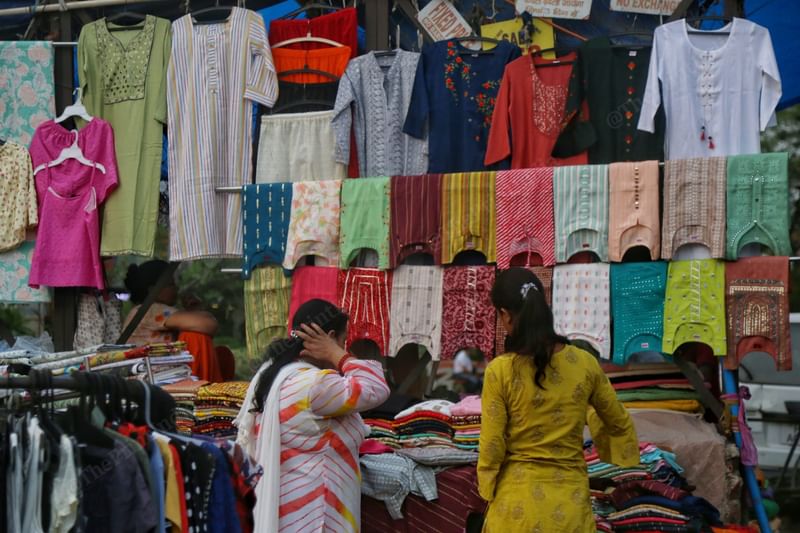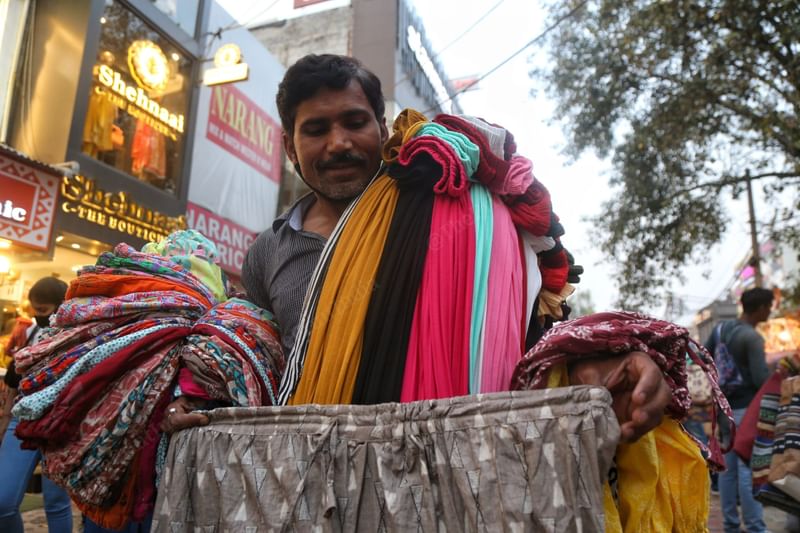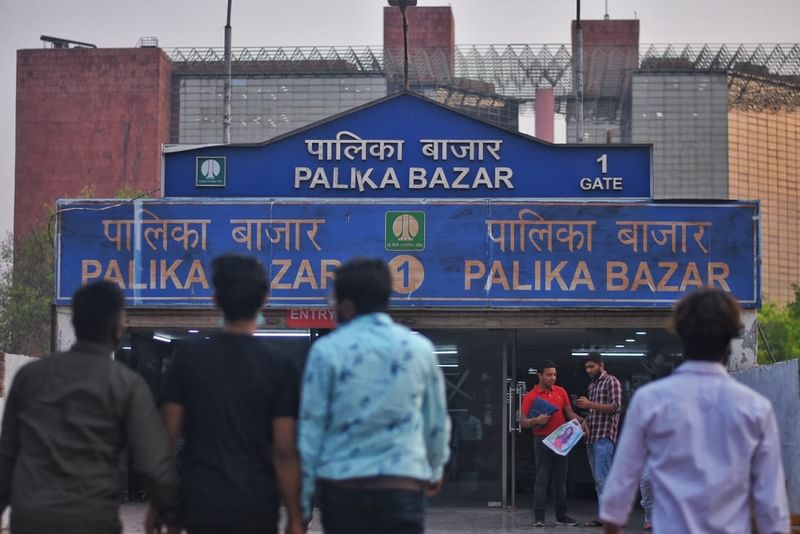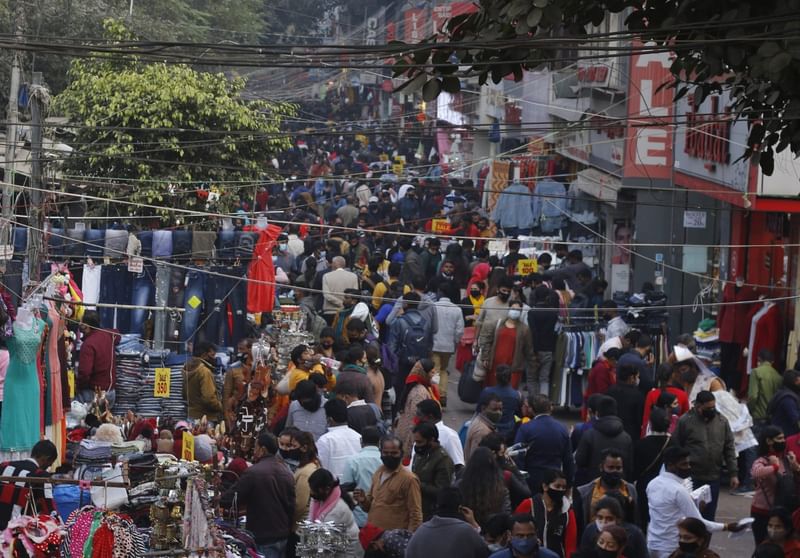INDIA
Sweatshops behind Sarojini: Masterjis and women who run Delhi’s ‘pocket-friendly’ fashionThere's a reason Delhiites can live up to their forever dressed-up, decked-up reputation. And it's hidden in the gullies of Ashok Bazaar and Tank road.
SHUBHANGI MISRA
4 April, 2022

Crowded Lajpat Nagar market. | Photo Credit: Manisha Mondal
New Delhi: Calls of “100 rupaye, 100 rupaye, sab kuch 100 rupaye,”, “Madam jeans for 300 only!”, “Madam, A1 chappals for you, 150 only”, “Aapka dhyan kidhar hai? Sasta kapda idhar hai”, echo in the flea markets of Delhi — Sarojini Nagar and Lajpat Nagar to Janpath and Karol Bagh. In the background, like white noise, is the chatter of young and old, students and professionals, rich and not-so-rich alike. But no one hears the silent stitching machines hidden away behind the crammed establishments. Everyone is out to fill their wardrobes with pocket-friendly, trendy clothes. No one asks why the shopkeepers offer their wares at dirt cheap prices. No one notices the labour.
While tailors, the ‘masterjis’ of the world, who run the show from behind the curtain are mostly men, they’re accompanied by women who help in cutting, sewing, packing and finishing the product. For this, they’re paid a paltry sum of Rs 1.50 per cloth. Three women ThePrint spoke to said they make about Rs 500 a day, which means they cut about 300 clothes working for 12 hours on average. The load increases during festival time.
Studies across the world have shown that relentless work in sweatshops are detrimental to workers’ health, and leads to breathing difficulties because of long exposure to garment dust. Apart from that, there is also the question of back and joint pain.
New Delhi: Calls of “100 rupaye, 100 rupaye, sab kuch 100 rupaye,”, “Madam jeans for 300 only!”, “Madam, A1 chappals for you, 150 only”, “Aapka dhyan kidhar hai? Sasta kapda idhar hai”, echo in the flea markets of Delhi — Sarojini Nagar and Lajpat Nagar to Janpath and Karol Bagh. In the background, like white noise, is the chatter of young and old, students and professionals, rich and not-so-rich alike. But no one hears the silent stitching machines hidden away behind the crammed establishments. Everyone is out to fill their wardrobes with pocket-friendly, trendy clothes. No one asks why the shopkeepers offer their wares at dirt cheap prices. No one notices the labour.
While tailors, the ‘masterjis’ of the world, who run the show from behind the curtain are mostly men, they’re accompanied by women who help in cutting, sewing, packing and finishing the product. For this, they’re paid a paltry sum of Rs 1.50 per cloth. Three women ThePrint spoke to said they make about Rs 500 a day, which means they cut about 300 clothes working for 12 hours on average. The load increases during festival time.
Studies across the world have shown that relentless work in sweatshops are detrimental to workers’ health, and leads to breathing difficulties because of long exposure to garment dust. Apart from that, there is also the question of back and joint pain.

Shop in Lajpat Nagar market. | Photo Credit: Manisha Mondal
Satwant Singh, president of Tank Road wholesale traders’ association, explains that migrant labourers from Madhya Pradesh, Odisha, Uttar Pradesh, Bihar and Jharkhand, come to the area in search of employment. The labour, he says, is relatively cheap, which helps in keeping the prices of clothes on the lower spectrum.
Everyone in Delhi has theories for the low price of clothes in the flea markets— ranging from second-hand clothes to export surplus. But it’s the jam-packed wholesale markets with sweatshops inside them, perfectly hidden in the narrow gullies of the capital, that ensure Delhiites can live up to their forever dressed-up, decked-up reputation.
Also Read: Delhi’s bespoke shoemakers are carving out a market niche with focus on fit, quality
Satwant Singh, president of Tank Road wholesale traders’ association, explains that migrant labourers from Madhya Pradesh, Odisha, Uttar Pradesh, Bihar and Jharkhand, come to the area in search of employment. The labour, he says, is relatively cheap, which helps in keeping the prices of clothes on the lower spectrum.
Everyone in Delhi has theories for the low price of clothes in the flea markets— ranging from second-hand clothes to export surplus. But it’s the jam-packed wholesale markets with sweatshops inside them, perfectly hidden in the narrow gullies of the capital, that ensure Delhiites can live up to their forever dressed-up, decked-up reputation.
Also Read: Delhi’s bespoke shoemakers are carving out a market niche with focus on fit, quality
Ashok Bazaar and Tank road — their oral histories
Welcome to Ashok Bazar in East Delhi’s Gandhi Nagar where live wires hang just six feet above the ground, drains are clogged up, and hoards of people brisk-walk along gullies with shops on either side in the simmering heat when the mercury hits 40 degrees Celsius daily. About 11 kilometres from here is the Tank Road Market in Karol Bagh, which offers a similar experience.
These are two of the biggest garment manufacturing hubs in the capital — Ashok Bazar with 15,000 shops and 5,000 small cloth manufacturing factories and Tank Road Market with 4,000 shops and factories.
Traders and manufacturers sit together, working in tandem, making thousands of suits, kurtis, jeans, pants, socks, and underwear from 8 am to long after nightfall. Association heads of both markets say their daily turnover runs into crores of rupees. According to association owners, Gandhi Nagar has a reported daily turnover of Rs 400 crore, Tank Road Market has a Rs 500 crore monthly turnover.
Delhi’s markets have a significant clientele. “Sarojini shopkeepers have their agents stationed here, and we also have representatives in the market reading what kind of products women desire. Saket, INA, Karol Bagh… all of NCR buys clothes from us,” says KK Bali, president of Association of Readymade garments dealers, Ashok Bazaar.

A salesman in Lajpat Nagar market. | Photo Credit: Manisha Mondal
Representatives of textile mills from Ahmedabad, Mumbai (Greater Mumbai area), Surat, and even Bhilwara in Rajasthan have been stationed in the market, Bali says, so getting the required cloth is also smooth.
The 71-year-old Bali is also a treasure trove of the oral history of the market. He says that till 1972, Gandhi Nagar was a residential locality, when some cloth shops started cropping up, and a weekly cloth market started in ‘yamuna paar’. Shopkeepers, back then, used to source clothes from Sadar Bazaar and Azaad market and eventually diversified to importing clothes from Ludhiana and Kolkata.
The market picked up in the early ’80s, when political and social turmoil in Punjab forced hosiery traders and manufacturers out of Ludhiana, who came to Ashok Bazaar and set up shops. From there, Ashok Bazaar turned into Asia’s largest wholesale readymade garments hub. Currently, 3 to 4 lakh people are employed there.
Tank Road wholesale traders association president Satwant Singh said the market exclusively dealt in ‘export surplus’ before 1989. “If you go further back in history, this market was an international hub for fake hair and wigs,” he says. In the early ’90s, the market started evolving into a jeans manufacturing hub. “Jeans used to be too expensive for a common man to own. Inflation-adjusted, they didn’t cost any less than Rs 4,000. Our traders understood this problem and imported two machines to make jeans here at an affordable rate. They brought down the cost from Rs 4,000 to just 300. From there this market picked up and became a garment manufacturing hub,” he says
Representatives of textile mills from Ahmedabad, Mumbai (Greater Mumbai area), Surat, and even Bhilwara in Rajasthan have been stationed in the market, Bali says, so getting the required cloth is also smooth.
The 71-year-old Bali is also a treasure trove of the oral history of the market. He says that till 1972, Gandhi Nagar was a residential locality, when some cloth shops started cropping up, and a weekly cloth market started in ‘yamuna paar’. Shopkeepers, back then, used to source clothes from Sadar Bazaar and Azaad market and eventually diversified to importing clothes from Ludhiana and Kolkata.
The market picked up in the early ’80s, when political and social turmoil in Punjab forced hosiery traders and manufacturers out of Ludhiana, who came to Ashok Bazaar and set up shops. From there, Ashok Bazaar turned into Asia’s largest wholesale readymade garments hub. Currently, 3 to 4 lakh people are employed there.
Tank Road wholesale traders association president Satwant Singh said the market exclusively dealt in ‘export surplus’ before 1989. “If you go further back in history, this market was an international hub for fake hair and wigs,” he says. In the early ’90s, the market started evolving into a jeans manufacturing hub. “Jeans used to be too expensive for a common man to own. Inflation-adjusted, they didn’t cost any less than Rs 4,000. Our traders understood this problem and imported two machines to make jeans here at an affordable rate. They brought down the cost from Rs 4,000 to just 300. From there this market picked up and became a garment manufacturing hub,” he says
Why prices are low
Apart from cheap labour, ‘illegally’ sourced export surplus from Bangladesh and second-hand clothes also ensure prices are under the Rs 500 range.
Tank Road also has a lot of traders dealing in export surplus material. From Zara to Jack and Jones to Levis and Nike to Adidas — you name the brand and it’s there in the market. Traders get Bangladesh’s surplus clothes from Kolkata. However, they may not always take the legal route. “Most of the export surplus clothes come into the country from Bangladesh or China, but most of these links have been illegally established,” Bali said.

A picture of Palika Bazar gate. | Photo Credit: Suraj Singh Bisht
Second-hand clothes make up a minuscule percentage of the clothes traded. “Clothes are sent for washing and dying in Faridabad, Panipat… from here they come refurbished, ready to be used by Delhi’s women,” said a trader who didn’t wish to be named.
Also Read: Research shows intermediaries’ role is misunderstood. Local market realities more at play
Demand for redevelopment
The old markets started in residential areas today are swollen to the brim. The overcrowded, narrow gullies are not just a hazardous set-up but also hinder businesses.
“Businessmen from around the world come to Ashok Bazaar, but we don’t even have a multi-level car parking where visitors can park their cars. There are long traffic jams every day. A lot of pollution and loss to our business occurs because of this,” Bali said.
Second-hand clothes make up a minuscule percentage of the clothes traded. “Clothes are sent for washing and dying in Faridabad, Panipat… from here they come refurbished, ready to be used by Delhi’s women,” said a trader who didn’t wish to be named.
Also Read: Research shows intermediaries’ role is misunderstood. Local market realities more at play
Demand for redevelopment
The old markets started in residential areas today are swollen to the brim. The overcrowded, narrow gullies are not just a hazardous set-up but also hinder businesses.
“Businessmen from around the world come to Ashok Bazaar, but we don’t even have a multi-level car parking where visitors can park their cars. There are long traffic jams every day. A lot of pollution and loss to our business occurs because of this,” Bali said.

Picture of a crowded Sarojini Nagar market. | Photo Credit: Suraj Singh Bisht
“The municipal corporation does nothing. For 5,000 shops here there are only three toilets. The association has had to maintain them. We’ve stationed staff there for daily cleaning,” complained Singh.
Delhi’s deputy chief minister Manish Sisodia recently proposed a plan to redevelop the city’s markets. Wholesale market associations are hopeful that Sisodia will turn his gaze at them too and redevelop areas the way Chandni Chowk has been.
Clogged drains, narrow lanes, wires hanging loose, electricity towers in the middle of the road, long traffic jams and lack of transport are some of the things that need addressing. But Sisodia’s Rs 100 crore set aside for redevelopment has been termed too little. The government might have to loosen its purse strings a bit and be more liberal.
(Edited by Srinjoy Dey)
“The municipal corporation does nothing. For 5,000 shops here there are only three toilets. The association has had to maintain them. We’ve stationed staff there for daily cleaning,” complained Singh.
Delhi’s deputy chief minister Manish Sisodia recently proposed a plan to redevelop the city’s markets. Wholesale market associations are hopeful that Sisodia will turn his gaze at them too and redevelop areas the way Chandni Chowk has been.
Clogged drains, narrow lanes, wires hanging loose, electricity towers in the middle of the road, long traffic jams and lack of transport are some of the things that need addressing. But Sisodia’s Rs 100 crore set aside for redevelopment has been termed too little. The government might have to loosen its purse strings a bit and be more liberal.
(Edited by Srinjoy Dey)
No comments:
Post a Comment